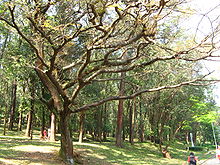Copaiba

Copaiba is an oleoresin obtained from the trunk of several pinnate-leaved South American leguminous trees (genus Copaifera). The thick, transparent exudate varies in color from light gold to dark brown, depending on the ratio of resin to essential oil. Copaiba is used in making varnishes and lacquers.
The
Copaiba is also a common name for several species of trees of the legume family native to Tropical Africa and North and South America.
Uses

Copaiba is particularly interesting as a source of biodiesel, because of the high yield of 12,000 L/ha (1,300 US gal/acre). The resin is tapped from standing trees, with an individual tree yielding 40 L (11 US gal) per year.[4][5]
Copaiba oil-resins extracted have been used in
The balsam and its oil are used as fixatives in soap perfumes and fragrances.[1]
Copaiba is also used as an artist material, especially in oil paint recipes and in ceramic decoration. Mineral painters use a medium made of copaiba, turpentine and lavender to mix with their minerals for adhesion to ceramic vessels before kiln firing. Copaiba makes a good medium for oils and helps with both adhesion and quality of shine.[citation needed]
Industry and commerce
The production of copaiba oil is socially significant to the Amazon because it represents approximately 95% of Brazil's oil-resin production industry. The Annual production of copaiba oil in the Amazon is estimated to be 500 tons/year.[8] The commercialization of copaiba as an oil or in capsule form has grown because of demand by traditional and widespread use, and is exported to other countries, including the United States, France, and Germany.[9]
The Food and Chemicals Codex lists copaiba oil as safe as a flavoring agent for foods.[10] Copaiba oil has both an acute oral and dermal LD50 exceeding 5 g/kg,[11] which classifies it as non-toxic.[12]
References
- ^ a b Karl-Georg Fahlbusch; et al. (2007), "Flavors and Fragrances", Ullmann's Encyclopedia of Industrial Chemistry (7th ed.), Wiley, p. 96
- ^ Valdir F. Veiga Jr. et al, Phytochemical and Antioedematogenic Studies of Commercial Copaiba Oils Available in Brazil; Phytotherapy Research, 15, 476-480 (2001).
- S2CID 258704922.
- Sydney Morning Herald. 2006-09-19. Retrieved 2006-10-14.
- ^ "New fuel source from trees". Australian Broadcasting Corporation. 2007-04-24. Retrieved 2007-04-26.[dead link]
- PMID 23055807.
- ^ Duke, James A. (1982). "Copaifera langsdorfii Desf.". Handbook of Energy Crops. Purdue Center for New Crops.
- ^ Sustainability of extraction and production of copaiba (Copaifera multijuga Hayne) oleoresin in Manaus, AM, Brazil. (Medeiros and Vieira, 2008; Brazil, 2011). Medeiros RD, Vieira G. For Ecol Manage. 2008;256:282–288.
- S2CID 29960482.
- ISBN 0-309-05394-3
- ^ D. L. J. Opdyke, Food and Cosmetics Toxicology, Vol 14, p. 687 (1976)
- ISBN 978-0443052606.


